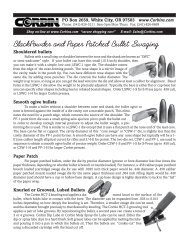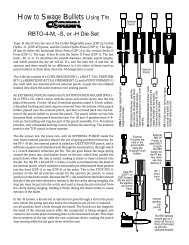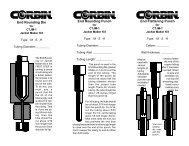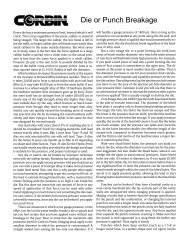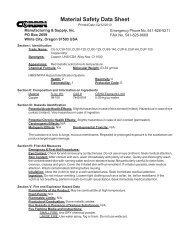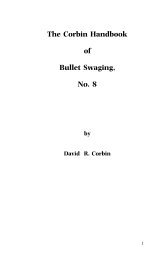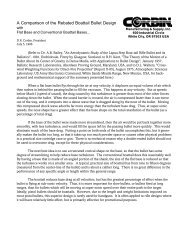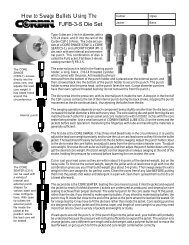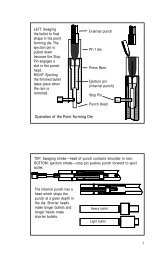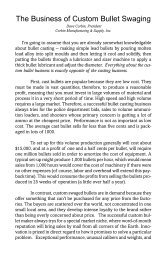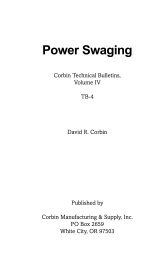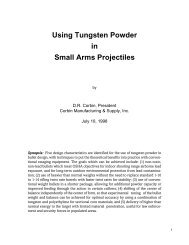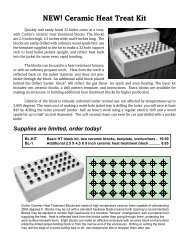HB-9 updated text (PDF) - Corbin Bullet Swaging
HB-9 updated text (PDF) - Corbin Bullet Swaging
HB-9 updated text (PDF) - Corbin Bullet Swaging
Create successful ePaper yourself
Turn your PDF publications into a flip-book with our unique Google optimized e-Paper software.
Usually, the design of a swaging press gives you a big advantage in<br />
speed, accuracy, and safety over using other kinds of presses. After all, a<br />
pants press, a wine press, a full court press, and a printing press all are<br />
variations on the term “press”, and they are not suitable for reloading.<br />
Having said this, it is still possible to have custom dies built for just about<br />
any press you own. Just bear in mind that there is time involved in making<br />
working drawings, checking the stroke and ejection position, getting<br />
special thread taps and dies (sometimes), setting up the tooling for a onetime<br />
job, and other costs that have long been amortized over thousands<br />
of dies when you choose a standard production design instead.<br />
Besides, we may have spent a couple of decades and tens of thousands<br />
of dollars in testing and improving our standard tools and presses.<br />
Building something for the first time in a different design often requires<br />
some investment in development, which may be a waste of your money<br />
if we’ve already done it a thousand times before in a different and better<br />
system, which would be yours if you just got the right platform to run it<br />
(the proper press). With a different, special tool, you get to pay for any<br />
unforseen development requirements. With our own products, we already<br />
paid for development and you get to benefit from that. It’s usually a better<br />
deal.<br />
<strong>Swaging</strong> Principles<br />
1. Always swage “up”, never “down”. <strong>Swaging</strong> down is a contradiction.<br />
You “draw” down, by pushing something through an open ended<br />
ring die, like our JRD-1 jacket drawing die, or BRD-1 bullet reducing die.<br />
Drawing makes the part smaller in diameter and longer. It can also cause<br />
separation of the core and jacket if done to excess. <strong>Swaging</strong> makes the<br />
part shorter and larger, and tightens the grip of the jacket on the core.<br />
2. Pay attention to the instructions. If there are special written notes<br />
with your die, they are important because they modify or improve the<br />
general instructions and replace them. If there is a difference between<br />
specific notes sent with your set of dies, and anything published in general<br />
(as in this book or in general printed literature), follow the special<br />
written instructions in any respect where they may differ. <strong>Swaging</strong> is partly<br />
an art, and various materials or sizes may react differently to the same<br />
general kind of operations.<br />
3. Use the right terminology! I cannot stress enough how important it<br />
can be to read what you have before you start to use it, and order the right<br />
part numbers and names of parts. People call the external punch everything<br />
from a “pin” to a “ram” to a “die” to a “die punch”. How are we<br />
supposed to know what you mean? If you order it wrong, you get to pay<br />
23



